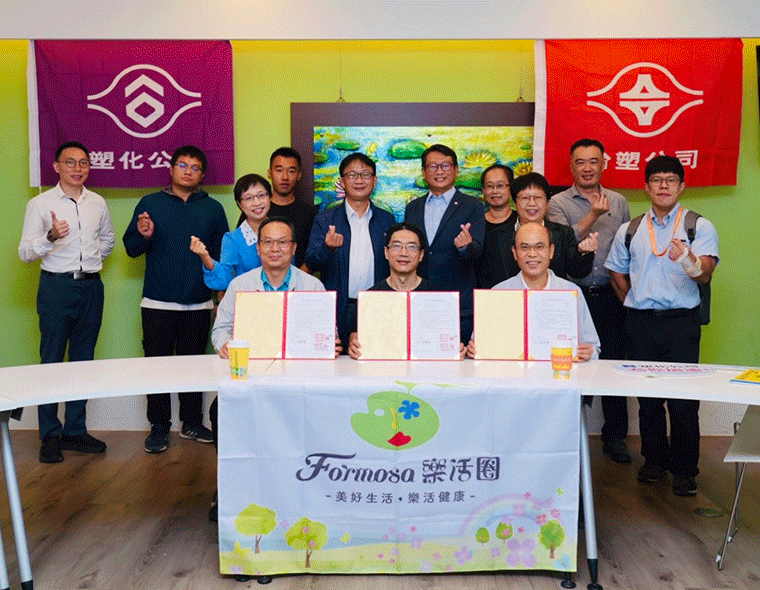The fast-disappearing Taiwanese fiddler crabs have returned. According to investigations con-ducted by the National Chung Hsing University (NCHU), a large number of Taiwanese fiddler crabs have appeared at the estuary of Jhoushuei River north of the Mailiao Industrial Port under Formosa Plastics Group (FPG), with the number exceeding 80% of the total population in Taiwan. To protect this rare endemic species of Taiwan, Formosa Plastics and Formosa Petrochemical Cor-poration have signed a memorandum of understanding (MOU) with the Research Center for Global Change Biology, NCHU, to work together on promoting the conservation of Taiwanese fiddler crab and environmental education.
Ecological Miracle at the Jhoushuei River Estuary
The estuary of Jhoushuei River in Mailiao Township, Yunlin County, once suffered from severe dust pollution. After the Fourth River Management Office of the Water Resources Agency, Minis-try of Economic Affairs, and the Yunlin County Government jointly managed this issue, the dust problem of Jhoushuei River has now been significantly improved. Due to the lack of vegetation at the Jhoushuei River estuary over a long period of time, FPG specially provided power to more than 20 wells for water supply to enhance the green coverage and water coverage. With the effort of many parties, the former sandbar has now been turned into a large green area and has now even become a wild bird haven.
At present, the estuary of Jhoushuei River enjoys a rich biodiversity, with not only rare birds, such as Oriental storks and Black-faced spoonbills, but also serves as a habitat of fiddler crabs, especially the endemic species and genus “Taiwanese fiddler crab”. In the past, there were records of this species in Penghu, Yilan, Keelung, Tamsui (New Taipei City), Xiangshan (Hsinchu), Wuqi (Taichung), Shengang and Fangyuan (Changhua), Dongshi (Chiayi), Beimen, Cigu, Anping (Tai-nan), and Yongan (Kaohsiung), but now the populations have disappeared from many areas.
In recent years, the research team from the Research Center for Global Change Biology, NCHU, has updated the distribution range of the Taiwanese fiddler crab, with the northern and southern boundaries being Tamsui in New Taipei City and Linyuan in Kaohsiung respectively. Out of which, the populations on the north and south shores of the Jhoushuei River estuary are the largest, accounting for more than 80% of the total population in Taiwan, while those in Penghu no longer exist. The drought in Taiwan has caused the decline and even disappearance of the Taiwan-ese fiddler crab population, which is a matter that deserves attention and protection from all sec-tors.
Industry, Government, and Academia Working Together to Revive the Jhoushuei River Environment
The Taiwanese fiddler crab is under pressure to survive in many places in Taiwan. After the ef-forts of so many parties, it is wonderful that such an important species are appearing in large num-bers at the estuary of Jhoushuei River north of the Mailiao Industrial Port, FPG. With regards to the conservation of Taiwanese fiddler crab at the Jhoushuei River estuary and the promotion of environmental education, Formosa Plastics and Formosa Petrochemical Corporation have signed a MOU with the Research Center for Global Change Biology, NCHU. Director Lee Youe-Ping of the Fourth River Management Office, Water Resources Agency, Ministry of Economic Affairs; Central Counselling Center of Regional Revitalization, National Development Council; and Chairman Wu Ming-Yi of the Mailiao Cultural Association in Yunlin were invited to witness this important moment.
Professor Shih Hsi-Te of NCHU said that, in cooperation with FPG, there will be long-term monitoring of the mangroves, substrate composition, and Taiwanese fiddler crab population on the northern shores of the Xucuoliao Fishing Harbor, in order to explore the impact of the mangroves on the Taiwanese fiddler crab and the extent of the population dynamics. By analyzing the rele-vant data, they will be able to understand the impact of mangroves on the Taiwanese fiddler crab population.
Director Lee Youe-Ping of the Fourth River Management Office, Water Resources Agency, said that the remediation measures for the dust pollution of Jhoushuei River has changed the eco-system of the entire Jhoushuei River estuary. It has become a precious natural habitat for birds, attracting more than 200 species of migratory birds, including the Oriental stork, which is in dan-ger of extinction globally. Recently, more than NT$47 million have been spent to build an eco-revitalization base at the Jhoushuei River estuary to promote local revitalization. The Fourth River Management Office considers it very meaningful for FPG to cooperate with NCHU to promote environmental education through this opportunity. The Fourth River Management Office will also be organizing a series of workshops as a platform to integrate the views of all parties to promote environmental education.
FPG pointed out that through this cooperation with NCHU, after the relevant research data have been analyzed and compiled, we look forward to producing eco-brochures, manuals, and en-vironmental education lesson plans related to Taiwanese fiddler crab. Together with the Fourth River Management Office, the Yunlin County Government, the National Development Council’s Central Counselling Center of Regional Revitalization, community revitalization groups, and schools, we look forward to doing something meaningful for Jhoushuei River through promoting environmental education and protection of Jhoushuei River by combining the power of enterprises, as well as the public and private sectors.


